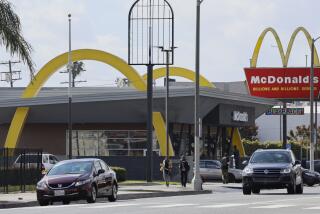Target to raise its minimum hourly wage to $15 by the end of 2020
- Share via
Reporting from NEW YORK — Target Corp. said Monday that it is raising the minimum wage for its workers to $11 an hour starting next month and then to $15 by the end of 2020.
The company said the move will help it better recruit and retain top-quality staff and provide a better shopping experience for its customers.
The initiative is part of the retailer’s overall strategy, announced this year, to reinvent its business, including remodeling stores, expanding its online services and opening up smaller urban locations.
Target quietly raised entry-level hourly wages to $10 last year, from $9 the previous year, following initiatives by Wal-Mart and others to boost wages in a fiercely competitive marketplace. But Target’s hike to $15 an hour far exceeds not only the federal minimum of $7.25 an hour but the hourly base pay at Wal-Mart, the nation’s largest private employer, and plenty of its other retail peers whose minimum hourly pay now hovers around $10.
As part of its $2.7-billion investment in workers, Wal-Mart Stores Inc. had raised its entry-level hourly pay for workers to $9 in 2015 and then to $10 in 2016. With Target’s outsized influence in the retailing world, its increase could force rivals to match the pay in order to compete.
“We see this not only as an investment in our team but an investment in an elevated experience for our guests and the communities we serve,” Brian Cornell, Target’s chief executive, told reporters during a conference call Friday.
Target’s planned minimum-wage increases outpace those mandated by California: Statewide, the minimum wage at medium and large employers is $10.50 an hour, and it’s not scheduled to reach $15 until 2022. Los Angeles, however, already has a minimum wage of $12 an hour at those employers, and the city requires a boost to $15 by mid-2020.
The changes come at a time when there’s growing concern for hourly workers. Thousands of workers have staged protests to call attention to their financial struggles and to fight for hourly pay of $15. The November election of a Republican-controlled Congress dampened hopes of an increase in the $7.25-an-hour federal minimum wage. But advocates have continued to press for boosts on the state and local level.
At the same time, competition for lower-skilled workers has heated up, and retailers, likely hobbled by the threat of e-commerce, are falling behind. As shoppers get more mobile-savvy, retailers are seeking sales staff who are more skilled at customer service and in technology, such as using iPads to check out inventory. But with the unemployment rate near a 16-year low, the most desirable retail workers feel more confident in hopping from job to job.
Thirty-two percent of all first jobs in the U.S. are in retail, according to the National Retail Federation, the nation’s largest retail group, and stores overall have more job openings now than they did a few years ago.
Hourly pay at restaurants and hotels is up 3.5% from a year earlier, a much better raise than the 2.5% gain for all employees. For workers at transportation and warehousing companies, where e-commerce growth is fueling hiring, pay is up 2.7% in the last year. Retailers, however, have lifted pay just 1.8% in the last year. That may be spurring more workers to leave for better opportunities: Separate government data show the number of retail workers quitting their jobs this year and last is at the highest in a decade.
The average hourly pay for cashiers is now $10.14, according to the Hay Group’s survey of 140 retailers with annual sales of at least $500 million. The survey was conducted in May. A year ago, the hourly pay was $9.79.
Target said its minimum hourly wage of $11 is higher than the minimum wage in 48 states and matches the minimum wage in Massachusetts and Washington. It said the pay increase will affect thousands of its more than 300,000 workers, but it declined to quantify the percentage of its workforce. It said the increase to $11 an hour will apply to the more than 100,000 hourly workers that Target will be hiring for the holiday season.
Target declined to say what the average pay will be for its hourly workers with the increased wages.
The Minneapolis company reiterated its third-quarter and full-year profit guidance but said that it would update investors early next year about how the wage investments will affect long-term profits.
Target’s wage increases come as the discounter is seeing signs that its turnaround efforts are starting to win back shoppers.
In August, Target reported that a key sales figure rose in the second quarter, its revenue beat Wall Street expectations and its online sales jumped 32%. The increase for the key sales measure reversed four straight quarters of declines. At that time, the company also boosted its earnings expectations for the year. Target is spending $7 billion over three years to remodel old stores, open small ones in cities and college towns and offer faster delivery for online orders. It is also adding more clothing and furniture brands, and said that its children’s line, Cat & Jack, brought in $2 billion in sales since its launch a year ago.
Cornell said Target has been moving toward dedicated workers in specific areas such as beauty and clothing, and that the wage increases will only help improve customer experience.
Wal-Mart has been benefiting from its investment in its workers. The Bentonville, Ark., retailer has seen lower turnover among workers and has gotten much better scores by customers for its service. Wal-Mart’s namesake U.S. division reported a 1.8% increase in revenue at stores open at least a year during its fiscal second quarter, marking the 12th straight period of gains. Wal-Mart’s wage investments, however, did take a big bite out of profits.
ALSO
Is Disney paying its share in Anaheim?
Behind a $13 shirt, a $6-an-hour worker
Uber CEO apologizes to London: Company ‘got things wrong along the way’
Wal-Mart wants to send people into your house to stock the fridge when you’re not home
Hewlett Packard Enterprise to cut 5,000 jobs, 10% of its workforce, report says
UPDATES:
3:45 p.m.: This article was updated with information about minimum wages in California and Los Angeles.
This article was originally published at 5:50 a.m.
More to Read
Inside the business of entertainment
The Wide Shot brings you news, analysis and insights on everything from streaming wars to production — and what it all means for the future.
You may occasionally receive promotional content from the Los Angeles Times.










